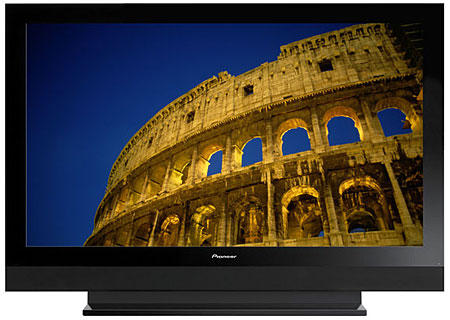Pioneer KURO PDP-6010FD 1080p 60" Plasma Display

KURO is a Japanese word meaning deep, black, and penetrating. Pioneer's. The fruit of this labor is eight new plasmas ranging in size from 42" to 60" and in price from $2,700 to $7,500. The PDP-6010FD ($6,500) under review here is the largest 1080p set in Pioneer's standard plasma line.
Longer, Lower, Blacker
All of Pioneer's new plasmas, both standard and Elite, employ the same palette of improvements that KURO technology offers, though there are subtle differences. The Elite sets offer a few additional features (including ISF calibration modes) and, according to Pioneer, also use a slightly darker filter for even deeper blacks.
According to Pioneer, the KURO sets are radically changed from last year's designs. The panel is new, the color filters are new, and there's a new ASIC said to improve the video processing for both high-definition and standard definition sources.
Pioneer recognizes current market realities with its input complement. On the back of the PDP-6010FD are four—count 'em—four HDMI input and a CableCARD HD tuner.
On the left side of the set is an additional jack panel with a single video input and a USB jack for viewing digital photos.
The Pioneer comes with a one-box, two-channel speaker that may be fastened to the bottom of the set or left off it you don't need it.
Pioneer's remote is a good one, and its large, well-spaced buttons are easy to find, even in the dark. That's good, because the remote is not backlit. The buttons are fluorescent and glow somewhat in the dark, but that's a weak substitute for full backlighting. It's also a universal design that may be programmed to operate up to three other devices
Setup and Control
Everything you'll need to adjust and operate the PDP-6010FD is in the on-screen menus. There are six different operating modes: Optimum, Standard, Dynamic, Movie, Game, and User.
The main video controls, including the usual Contrast, Brightness, Color, Tint, and Sharpness, may be adjusted by the user for all of these modes except for Dynamic. Any adjustments you choose to make for the other modes, except for User, will apply to any input for which you select that mode. That is, you can't create a uniquely adjusted Movie mode for each input.
With only a few minor adjustments Movie produced a well-adjusted picture 90% of the time, particularly in subdued room lighting and, especially, the near darkness I prefer for movie watching.
A Pro Adjust selection in the Picture menu opens up a list of other controls. PureCinema automatically detects film-based sources and offers three options. Standard, available with only 480i or 1080i sources, feeds the panel the usual film-based video source, complete with 3:2 pulldown. Smooth is said to produce "smoother and more vivid moving images." It may be proprietary as we could not get any details as to how it does this, but it does work—though the result is not always a plus and rarely dramatic. ADV converts film-based program material to a display rate of 72fps by eliminating 3:2 pulldown. If the program material is already at 1080p/24, however, this conversion triples the frame rate regardless of the PureCinema setting.
The Low color temperature option measured so close to the D6500 standard that I did not need to perform any service menu calibrations (see "Measurements").
Pro Adjust controls that I left Off included DRE (Dynamic Range Enhancement), Black Level (use the Brightness control for your black level adjustments), ACL (which is said to affect contrast, though I could never see any benefit to it), and CTI (Color Transient Improvement).
I left the Enhancer Mode ("enhances" image detail) in its factory setting: 2. The two noise reduction options, 3DNR and Field NR, worked well with some noisy sources without any clearly obvious loss of details. I normally left the Gamma control at 2.
The Pioneer can be set to change its aspect ratio automatically for HDMI sources, but only if those sources carry the proper digital flags to trigger the change.
Side Mask either sets the sidebars on 4:3 images to constant gray or varies them (though not by much) with brightness of the image. An Orbiter function (which shifts the image a few pixels at a time) may also be engaged. Both the Side Mask and Orbiter features are designed to minimize the possibility of image burn-in.
The Details
The Pioneer's picture is little short of jaw dropping. And a good share of the credit for this goes to the set's stunning black level and excellent shadow detail.
Like CRTs, plasma sets are self-illuminating (the phosphors that make up the pixels light individually, on cue). But unlike CRTs, the panel must be maintained in state of readiness—the idle luminance—in order to respond rapidly to the signal. This is the background black that you'll see on the screen any plasma display when it's turned on, the room lights off, and no signal on the input. That's as dark as the set will ever go.
Pioneer has managed to reduce this "black floor" by reducing the required idle luminance by 80%. This may well be the reason why, to date, I've tested no digital displays—front projector, rear projector, or flat panel, plasma, LCD, DLP, LCoS, or SXRD—that can match the Pioneer in its combination of deep, rich blacks and superb contrast, both ANSI and peak (see "Measurements"). And just as importantly, the uniformity of those blacks across the entire screen is superb as well.
- Log in or register to post comments














































